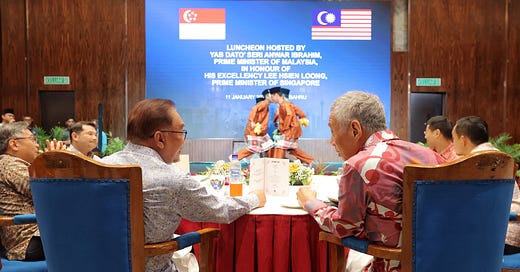Geoeconomic Game-Changer Across the Malaysia-Singapore Border?
Plus ASEAN's 2024 Myanmar focus; crime uptick in Asia's waters; shifting investment screening landscape; evolving 5G network dynamics and much more.
Greetings to new readers and welcome all to the latest edition of the weekly ASEAN Wonk BulletBrief! A quick note that starting from this week, we will begin reserving iterations of our popular WonkDive analysis section for our paid subscribers and adjusting our sequencing accordingly. If you haven’t already, you can upgrade to a paid subscription below to receive our full posts, with thanks for your support!
For this iteration of ASEAN Wonk BulletBrief, we are looking at:
Assessing the potential geoeconomic effects of cross-border Malaysia-Singapore cooperation amid wider regional and geopolitical trends;
Mapping of regional developments including ASEAN diplomacy on Myanmar’s ongoing civil war and Germany’s foreign minister sparking South China Sea headlines in the region;
Charting evolving trends such as on a crime uptick in Asian waters as well as Southeast Asia’s centrality in the global e-commerce boom;
Tracking and analysis of industry developments and quantitative indicators including a shifting investment screening landscape; evolving 5G network dynamics and more;
And much more! ICYMI, check out our review of a new book on the future of U.S.-China competition and implications for regions including Southeast Asia.
WonkCount: 1,778 words (~9 minutes reading time)
ASEAN’s 2024 Myanmar Challenge in Focus; Germany’s Foreign Minister Sparks South China Sea Headlines; Jokowi’s Southeast Asia Tour & More

Crime Uptick in Asian Waters; Southeast Asia’s Centrality in the Global E-Commerce Boom; ASEAN’s Evolving 2024 Agenda
“[M]ore needs to be done to eradicate the organized criminal groups operating in the Straits of Malacca, one of the busiest shipping lanes of maritime trade route in the world, with the Singapore Strait that connects the Indian Ocean and the Pacific, which has approximately 1,000 vessels plying its waters daily,” warns the 2023 review report of the Regional Cooperation Agreement on Combating Piracy and Armed Robbery against Ships in Asia (ReCAAP). The total number of incidents rose to 100 in 2023 from 84 in 2022 (see quarterly chart below), with 63 incidents in the Straits of Malacca and Singapore. On the positive side, ReCAAP noted a reduction in the level of threat in the Sulu-Celebes Seas, with the Philippine Coast Guard recently downgrading the threat of crew abduction from “moderate” to “moderately low” (link).
ReCAAP Recorded Number of Incidents By Quarter
“The fastest-growing e-commerce markets…are concentrated in the Asia-Pacific region, led by the Philippines, and followed in order by India, Indonesia, Malaysia, and Thailand,” per a new set of infographics published by the Hinrich Foundation on the global e-commerce market. It notes that by one count, Southeast Asian states account for 5 of the 10 fastest-growing e-markets in the world (see graphic below). Overall, the world’s $6 trillion e-commerce markets has still shown signs of surging, and it could capture over 40 percent of global retail sales by 2027 (more than double the rate just a decade earlier) (link).
Top E-Commerce Markets by Sales Growth Year-on-Year
“Laos needs to continue the efforts of Indonesia’s 2023 Chairmanship, particularly in upholding ASEAN’s unity and relevance and in leveraging new growth drivers such as green transition and digital transformation,” notes an article over at Fulcrum on how ASEAN can advance its priorities under Laos’ 2024 ASEAN chairmanship as it seeks to finalize its post-2025 vision. The piece suggests that Laos focus on issues such as boosting connectivity, narrowing the development gap, delivering high-impact wins under the ASEAN Economic Community (AEC) and advancing the foundations for a post-2025 AEC (link).
Geoeconomic Game-Changer Across the Malaysia-Singapore Border?
What’s Behind It
Leaders from Malaysia and Singapore oversaw the inking of a key pact that paves the way for the creation of a new special economic zone between them in the southern Malaysian state of Johor1. The two countries signed a memorandum of understanding on January 11 to work on the Johor-Singapore Special Economic Zone (JS-SEZ)2.
The move is the latest in a series of initiatives mulled by the neighboring countries over decades to boost cross-border cooperation amid lingering challenges. Despite the proximity between Malaysia and Singapore — briefly unified between 1963 and 1965 before separation — collaboration has at times been hindered by domestic political dynamics and a string of disputes including those related to water, airspace and maritime boundaries. Traction during the reign of former Malaysian premier Najib Razak (2009-2018), including plans for a new high-speed rail project unveiled in 2013, slowed as the massive 1MDB corruption scandal and a revolving door of prime ministers consumed Malaysia’s domestic politics. Cooperation has risen since Anwar Ibrahim took office in November 2022. At the tenth iteration of the Malaysia-Singapore Leaders’ Retreat last October, both sides took note of some inroads thus far, including new digital and green economy frameworks, cross-border QR-code payment linkages, and a new annual trade and investment ministerial3. The JS-SEZ, though still in its initial stages of formulation, has been hailed by some as a potential game changer4.
Why It Matters
The geoeconomic impact from realized cross-border cooperation could be significant, both in terms of aggregate collaboration as well as in specific sectors (see below for a table summarizing key initiatives and sectors).













